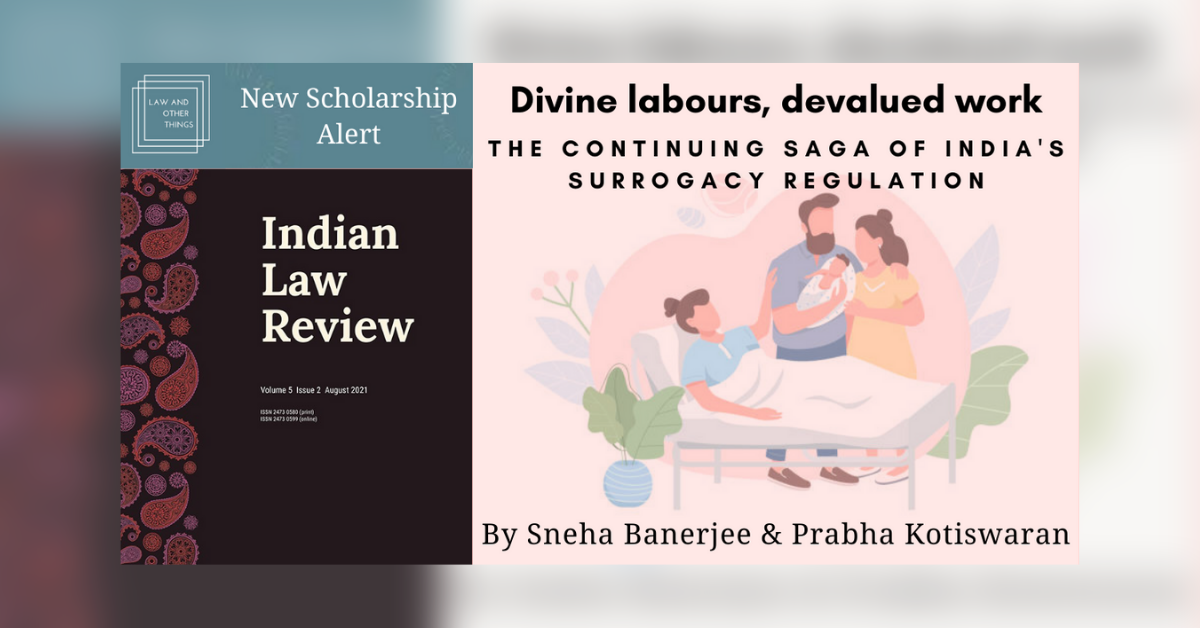Ed Note: As part of our New Scholarship section, we have been inviting discussants to respond to the public law themed articles featured in Volume 5 the Indian Law Review. You can access all the posts in this discussion here. In this post, Swati Gola responds to the arguments made by Sneha Banerjee and Prabha Kotiswaran in their paper titled “Divine labours, devalued work: the continuing saga of India’s surrogacy regulation”. You can access the article here and the summary of the paper here.
Regulation of surrogacy (whereby a woman carries a pregnancy to term and gives birth to a child for another), arrangements have presented multi-faced challenges for governments throughout the globe. Socio-ethical and legal challenges of unregulated commercial surrogacy finally prompted the Indian government to propose legislation to regulate surrogacy. The Indian government had introduced the Surrogacy (Regulation) Bill 2019 as the 2016 Bill has lapsed. Following the criticism, the Indian government has introduced further amendments in the 2019 Bill which now allows ‘any ‘willing’ woman to be a surrogate,’ an Indian Single Woman (only widow or Divorcee) to commission surrogacy and requires a ‘certificate of essentiality’ from the intending parent(s). The amended Bill awaits tabling in the parliament.
Prof. Prabha Kotiswaran and Dr. Sneha Banerjee’s paper ‘Divine labours, devalued work: the continuing saga of India’s surrogacy regulation‘ presents a critique of the 2019 Bill raising a number of concerns. In this blog, I will discuss lack of compensation, absence of a contract and the need to streamline surrogacy with assisted reproductive technologies. There are many ways of reading the 2019 Bill and in my response, I draw from a longer paper that I recently published.[1]
Remuneration for surrogacy services has been the most debated issue in regulation of surrogacy worldwide. Whereas unregulated commercial surrogacy led to the exploitation of surrogates in India, the provision of reasonable expenses for altruistic surrogacy has raised other issues in the UK where the surrogate is the legal mother of the child born of surrogacy. These issues include demands for expensive gifts by the surrogate in lieu of consent for parental order and the breakdown of relationship between the surrogate and the commissioning parents. At the same time, in jurisdictions like California, where commercial surrogacy is permitted and well regulated, baby selling rings have been apprehended wherein a prominent surrogacy attorney was involved.[2] The position posited in the paper, i.e., material feminism supports compensating the surrogate. However, the argument in the paper moves from reproductive autonomy to reproductive labour without deeply discussing either. For example, the paper first acknowledges that there is no right to reproduction under the Indian constitution referring to the Puttaswamy[3] judgement wherein the court upheld a right of reproductive autonomy as the constitutionally guaranteed right to privacy. However, it is not clear how the right to reproductive autonomy of the intending parent(s) extends to using another person’s (surrogate’s) body to fulfil their liberty of procreation. Then the paper raises the reproductive labour argument for compensating the surrogate but the case law[4] used to support the argument remarked on unpaid domestic and care work that a housewife engages in. The paper argues that these judgements implicitly recognise the reproductive labour performed by mothers in bearing children, including awarding compensation for the loss of a foetus but present no reasoning from within the judgements in support. It would have helped the reader a lot if the theoretical foundation had been provided in the paper which would have grounded their argument for compensated surrogacy better in the case law. In my paper, I too have criticised the proposed format of altruistic surrogacy for reducing the surrogate to a mere gestational carrier especially since the surrogate is barred from using her own eggs. Such an approach coupled with the requirement to pass the legal parentage to commissioning couple prior to surrogacy dismisses the surrogate’s status as a mother disqualifying her from any incentives of motherhood like maternity pay. It further undermines her reproductive labour and ignores the physical and psychological health risks and repercussions of a heavily medicalised pregnancy and birthing process.
The paper notes the need for an expansive agreement/contract between the surrogate and the intending parents detailing the rights and duties of the parties. However, existing unequal bargaining power leading to unconscionable exploitative arrangements in the commercial surrogacy agreements has been the one of the reasons the government is called upon to regulate surrogacy in India. If the rights and duties emanate from a contract, the intending parents being in a socioeconomically superior position will always be able to impose restrictive conditions on surrogates binding her to her contractual obligations. The US case, Cook v Harding[5] is an example of such a scenario where the intending father refused to pay for high-risk triplet pregnancy and demanded a reduction abortion that was refused by the surrogate mother. By refusing to reduce, the surrogate was claimed to be in breach of the contract and liable for monetary damages including the medical treatment for a resulting child. Therefore, a contractual arrangement will not be beneficial unless independent legal advice can be provided for the surrogate. The paper, while criticising the Bill for omitting the provision for a contract, stops short of making any recommendation such as what a model surrogacy contract would look like, i.e., what rights and duties are paramount for each party.
Finally, a very pertinent issue that the paper successfully raises is the need to streamline surrogacy with associated assisted reproductive technologies (ART), particularly the regulation of gamete donation process and protection of egg donors to be at par with the surrogate. Rooted in complex social and cultural contexts, ARTs primarily rely on women’s bodies as egg donors or surrogates. Even in the case of male infertility, most of the treatments are administered to women, who thus bear most of the health risks.[6] Research has noted egg donation preceding surrogacy in case of many surrogates.[7] Unlike sperm donation, retrieval of eggs from the woman’s body is an intrusive medical procedure wherein ‘egg harvesting’ is done under anaesthesia posing health risks, including ovarian hyper-stimulation syndrome.[8] And yet, as the authors noted, even the ART Bill doesn’t provide adequate protection for egg donors. To this end, it is essential that the provisions as well as the definitions in the two legislations, the Surrogacy (Regulation) Bill and the ART Bill are streamlined and cross-referenced.
Regulation of ARTs as well as surrogacy is the need of the hour given the exploitative conditions under which commercial surrogacy has proliferated in India. However, the conflicting interests of the surrogates, intending parties and the child born of surrogacy have to be balanced in any prospective legislation. Whereas the right to reproductive autonomy is important, there is no right to have a child under the law as a child is a human being with her own rights. Moreover, the possible physical and psychological health risks for socio-economically weak surrogates cannot be undermined in the name of economic security and reproductive autonomy. At the same time, while regulating surrogacy, the State cannot cherry-pick the sections of society that can avail of surrogacy services. Therefore, any legislation aimed at regulating surrogacy needs to be equitable, grounded in the socio-cultural and economic realities of the Indian state and above all ensure that protection of one party’s interest doesn’t come at the cost of another.
Swati Gola is a lecturer at University of Exeter Law School. She has written papers on Socio-Legal Implications of Reproductive Tourism and Surrogacy in India; Medical Tourism and Health Equity.
[1] S. Gola, One step forward or one step back? Autonomy, agency and surrogates in the Indian Surrogacy (Regulation) Bill 2019, International Journal of Law in Context (2021), 17, 58–74 doi:10.1017/S174455232100001X.
[2] UN General Assembly Human Rights Council (2018) Report of The Special Rapporteur on The Sale And Sexual Exploitation of Children, Including Child Prostitution, Child Pornography And Other Child Sexual Abuse Material. UN Doc A/HRC/37/60. New York: United Nations.
[3] Puttaswamy v. Union of India [2017] Writ Petition Civ 494/12 (SC).
[4] National Insurance Co. Ltd. v. Minor Deepika 2009, MANU/TN [2009] 1304; Arun Kumar Agarwal v. National Insurance Company [2010] 9 SCC 218.
[5] Cook v. Harding, 190 F. Supp. 3d 921 (C.D. Cal. 2016).
[6] Ikemoto, L.C. (2009). ‘Reproductive Tourism: Equality Concern in the Global Market for Fertility Services.’ Law and Equality 27:294.
[7] SAMA-Resource Group for Women and Health (2012) Birthing A Market: A Study on Commercial Surrogacy. New Delhi: Impulsive Creations 1-156.
[8] Jyotsna Agnihotri Gupta, Reproductive Biocrossings: Indian Egg Donors and Surrogates in the Globalized Fertility Market. (2012) International Journal of Feminist Approaches to Bioethics 5(1):25-51.






Thanks for sharing. I read many of your blog posts, cool, your blog is very good.
Thank you for your sharing. I am worried that I lack creative ideas. It is your article that makes me full of hope. Thank you. But, I have a question, can you help me?
Your article helped me a lot, is there any more related content? Thanks!
Thank you for your sharing. I am worried that I lack creative ideas. It is your article that makes me full of hope. Thank you. But, I have a question, can you help me?